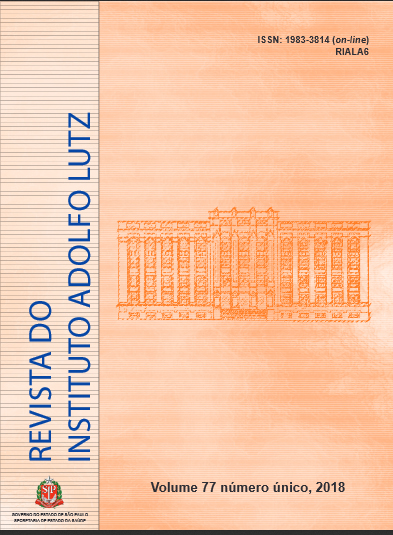Abstract
This study aimed at evaluating the occurrence of fraud, and the sanitary conditions of honeys sold in Natal, Brazil. Twenty samples of honey were analyzed, being the majority without labels, and obtained in small trades. The samples were subjected to qualitative physical-chemical analysis (Fiehe reaction, diastases enzymes, Lund and Lugol reaction); quantitative evaluation (moisture, ash, pH, acidity and 5-Hidroximetilfurfural (5-HMF); and microbiological (molds and yeasts, coliforms at 45 °C and Salmonella sp). In the Fiehe reaction, 40% of samples indicated excessive heating; diastase enzymes were absent in 60%. In the Lund reaction, 35% indicated adulteration, and 30% by the Lugol reaction. The humidity values varied from 15.80 to 20.53%, and one sample (5%) showed higher rate. The ash values (0.02 to 0.36%) were within the limit; pH values were
from 3.08 to 4.31. For acidity (21.99 to 78.88 mEq/kg) 40% of the values were higher than those allowed, and 20% of the 5-HMF (9.60 to 88.70 mg/kg) did not comply with the legislation. No microorganism growth was observed. The majority of the honey samples were in disagreement with the legislation, indicating overheating, and/or poor storage conditions or some form of fraud. Honey samples were in good hygienic-sanitary conditions.
References
1. Instituto Brasileiro de Geografia e Estatística - IBGE. Prod Pec munic [Internet]. 2013;41:1-108. Disponível em: https://biblioteca.ibge.gov.br/visualizacao/periodicos/84/ppm_2013_v41_br.pdf
2. Pucas A, Hosu A, Cimpoiu C. Application of a newly developed and validated high-performance thin-layer chromatographic method to control honey adulteration. J Chromatogr A. 2013;1272:132-5. https://doi.org/10.1016/j.chroma.2012.11.064
3. Mendes CG, Silva JBS, Mesquita LX, Maracajá PB. As análises de mel: revisão. Rev Caatinga [Internet]. 2009;22(2):7-14. Disponível em: https://periodicos.ufersa.edu.br/index.php/caatinga/article/view/789/633
4. Tornuk F, Karaman S, Ozturk I, Toker OS, Tastemur B, Sagdic O et al. Quality characterization of artisanal and retail turkish blossom honeys: Determination of physicochemical, microbiological, bioactive properties and aroma profile. Ind Crops Prod. 2013;46:124-31. https://doi.org/10.1016/j.indcrop.2012.12.042
5. Silva PM, Gauche C, Gonzaga LV, Costa ACO, Fett R. Honey: chemical composition, stability and authenticity. Food Chem. 2016;196:309-23. https://doi.org/10.1016/j.foodchem.2015.09.051
6. Lopes MTR. As boas práticas na colheita e qualidade do mel. Embrapa. [Internet]. 2008. Disponível em: https://www.agrolink.com.br/saudeanimal/artigo/as-boas-praticas-na-colheita-e-qualidade-do-mel_65668.html
7. Instituto Adolfo Lutz. Métodos físico-químicos para análise de alimentos: normas analíticas do Instituto Adolfo Lutz. 4.ed. [1. ed. Digital]. São Paulo (SP): Instituto Adolfo Lutz; 2008. Disponível em: http://www.ial.sp.gov.br/resources/editorinplace/ial/2016_3_19/analisedealimentosial_2008.pdf
8. Ministério da Agricultura, Pecuária e Abastecimento (BR). Instrução Normativa no 11, de 20 de outubro de 2000. Regulamento técnico de identidade e qualidade do mel. [acesso 2018 Mar 26]. Disponível em: http://extranet.agricultura.gov.br/sislegis-consulta/consultarLegislacao.do?operacao=visualizar&id=7797
9. Ministério da Agricultura, Pecuária e Abastecimento (BR). Instrução Normativa n° 62, de 26 de agosto de 2003. Oficializa os Métodos Analíticos Oficiais para Análises Microbiológicas para Controle de Produtos de Origem Animal e Água. [acesso 2018 Mar 26]. Disponível em: http://extranet.agricultura.gov.br/sislegis-consulta/consultarLegislacao.do?operacao=visualizar&id=2851
10. Ribeiro ROR, Silva C, Monteiro ML, Baptista RF, Guimarães CF, Mársico ET et al. Avaliação comparativa da qualidade físico-química de méis inspecionados e clandestinos, comercializados no estado do Rio de Janeiro, Brasil. Rev Bras Ciênc Vet. 2009;16(1):3-7. https://dx.doi.org/10.4322/rbcv.2014.160
11. Yücel Y, Sultanoglu, P. Characterization of honeys from Hatay region by their physicochemical properties combined whith chemometrics. Food Biosci. 2013;1:16-25. http://dx.doi.org/10.1016/j.fbio.2013.02.001
12. Abadico Finco FDB, Moura LL, Silva IG. Propriedades físicas e químicas do mel de Apis mellifera L. Ciênc Tecnol Aliment. 2010;30(3):706-12.
13. Liberato MCTC, Morais SM, Magalhães CEC, Magalhães IL, Cavalcanti DB, Silva MMO. Physicochemical properties and mineral and protein content of honey samples from Ceará state, Northeastern Brazil. Food Sci. Technol. 2013;33(1):38-46. http://dx.doi.org/10.1590/S0101-20612013005000028
14. Marchini LC, Moreti ACCC, Otsuk IP. Análise de agrupamento, com base na composição físico-química de amostras de méis produzidos por Apis mellífera L. no Estado de São Paulo. Ciênc Tecnol Aliment. 2005;25(1):8-17.
15. Moraes FJ, Garcia RC, Vasconcelos E, Camargo SC, Pires BG, Harleben AM et al. Caracterização físico-química de amostras de mel de abelha africanizada dos municípios de Santa Helena e Terra Roxa (PR). Arq Bras Vet Zootec. 2014;66(4):1269-75. http://dx.doi.org/10.1590/1678-6865

This work is licensed under a Creative Commons Attribution 4.0 International License.
Copyright (c) 2018 Joyce Karoline Lopes Marinho, Camila Vanessa da Silva Moreira, Letícia Costa Ferreira, Karla Suzanne Florentino da Silva Chaves Damasceno, Jéssica Anarellis Barbosa dos Santos, Nely Holland
